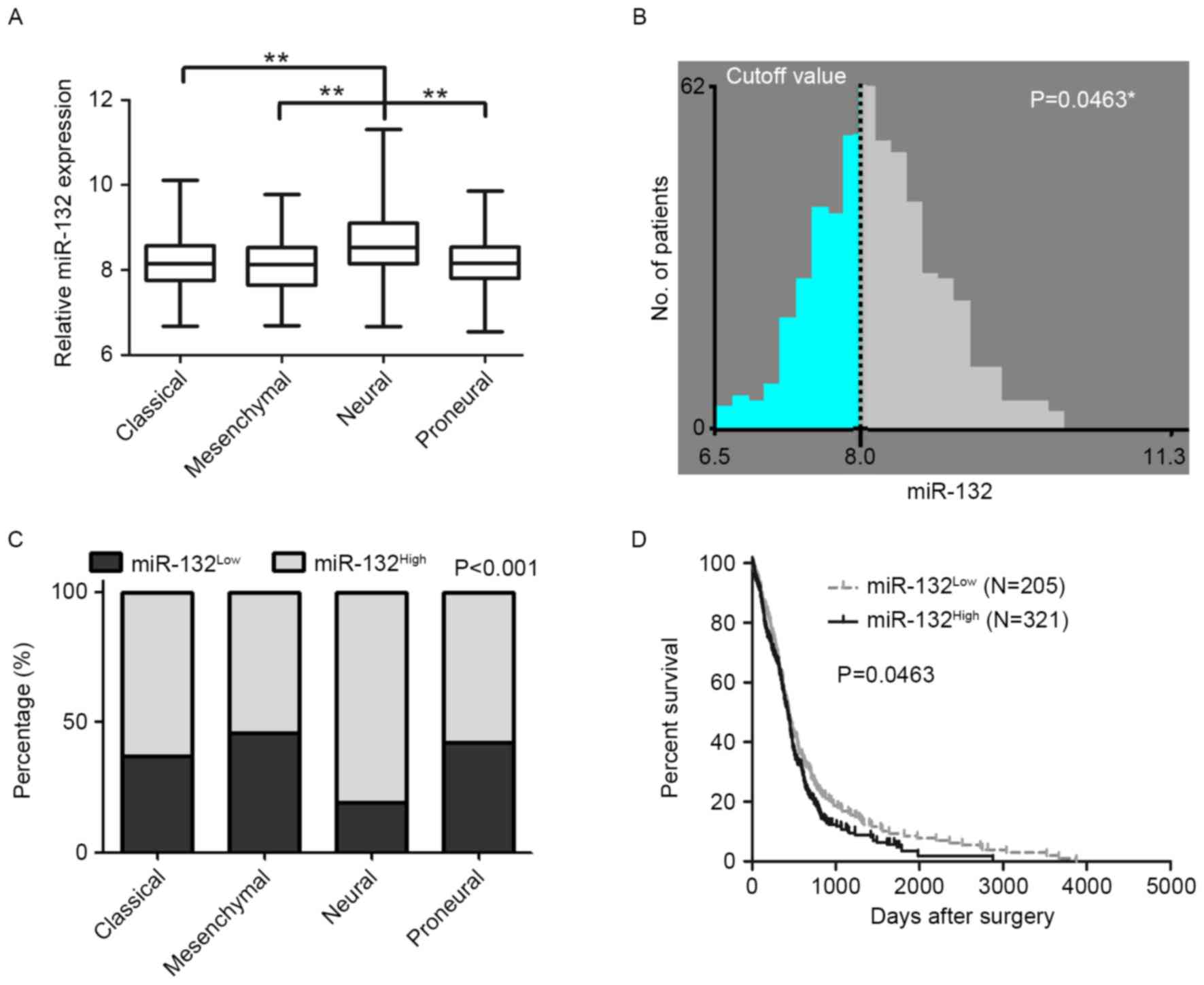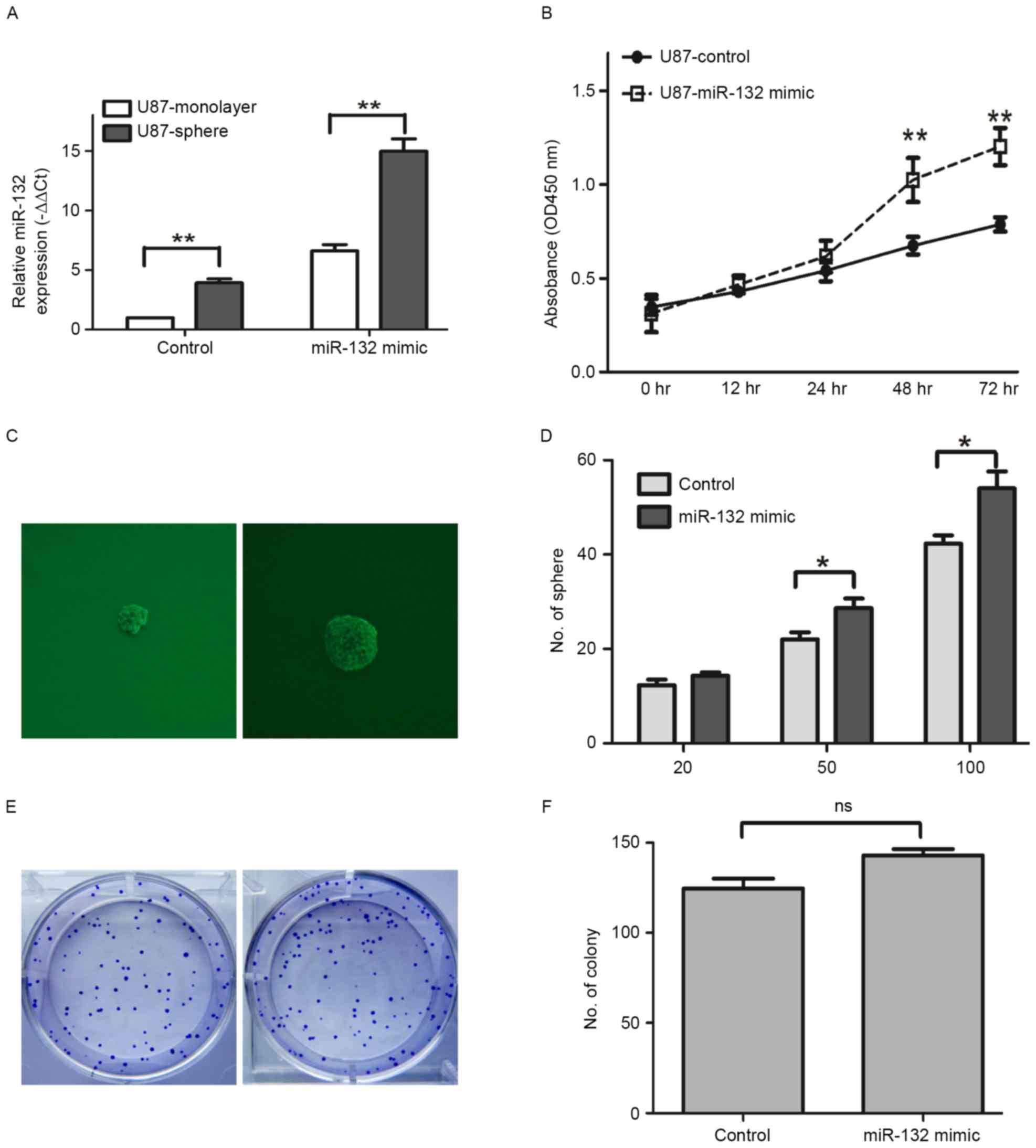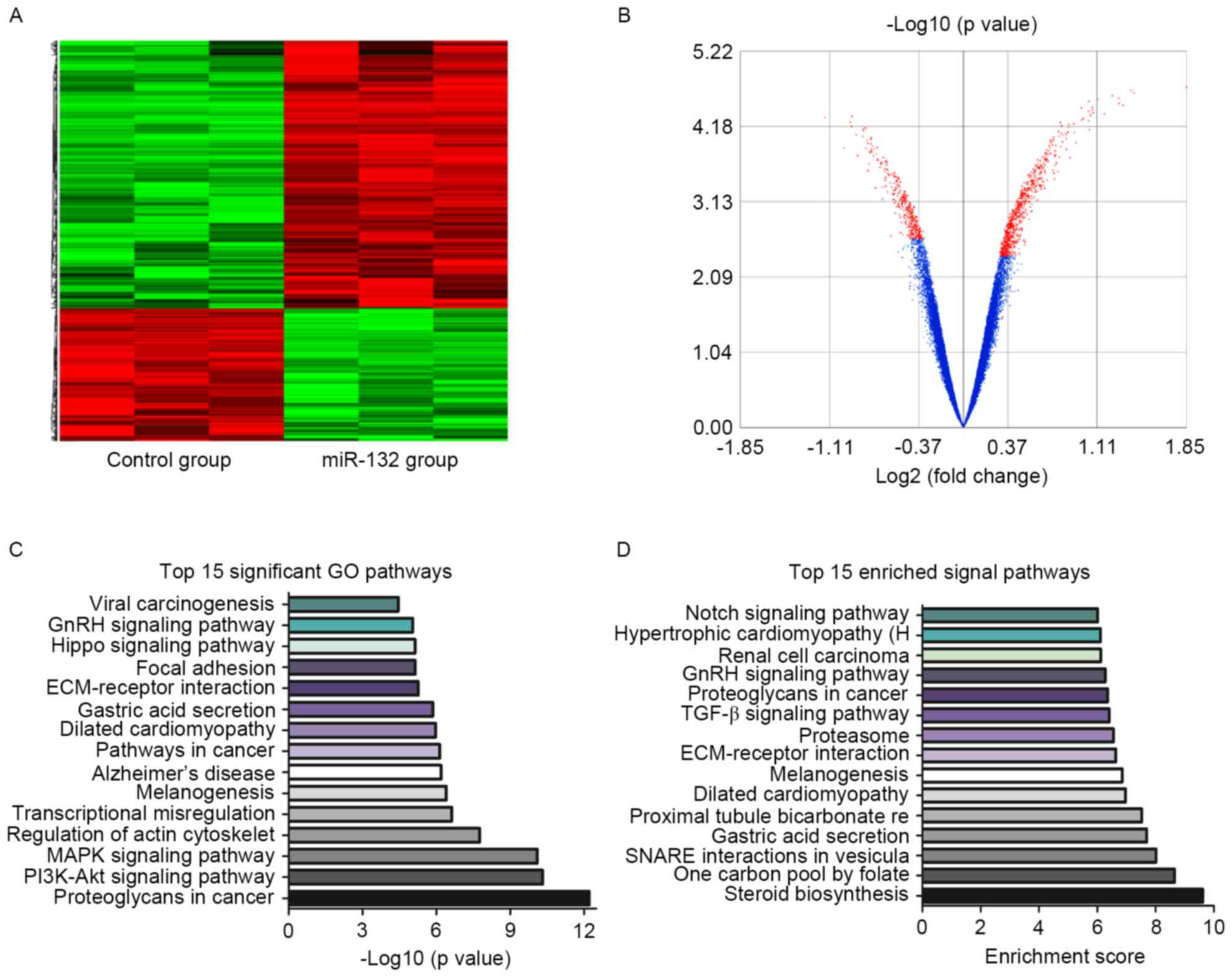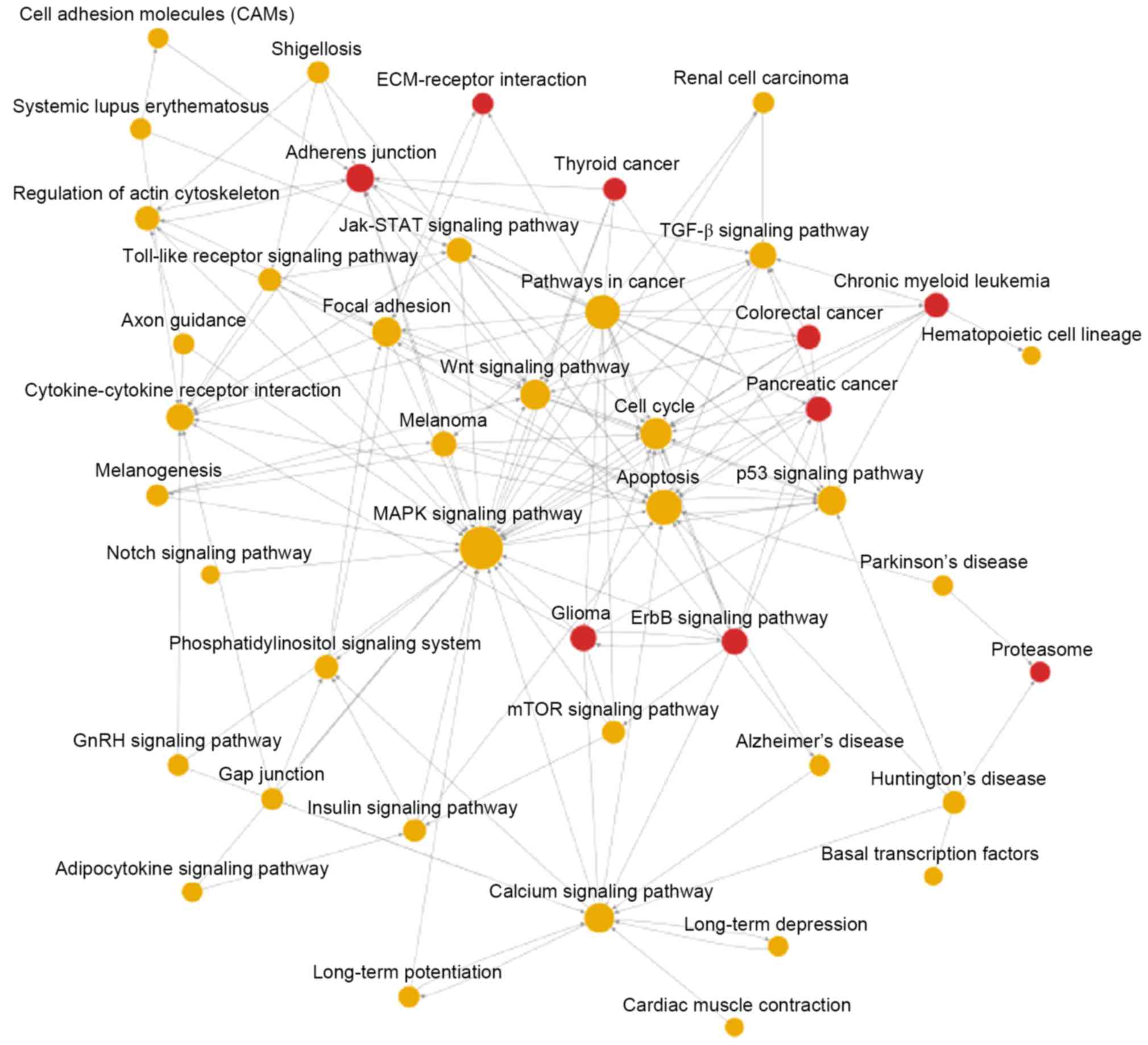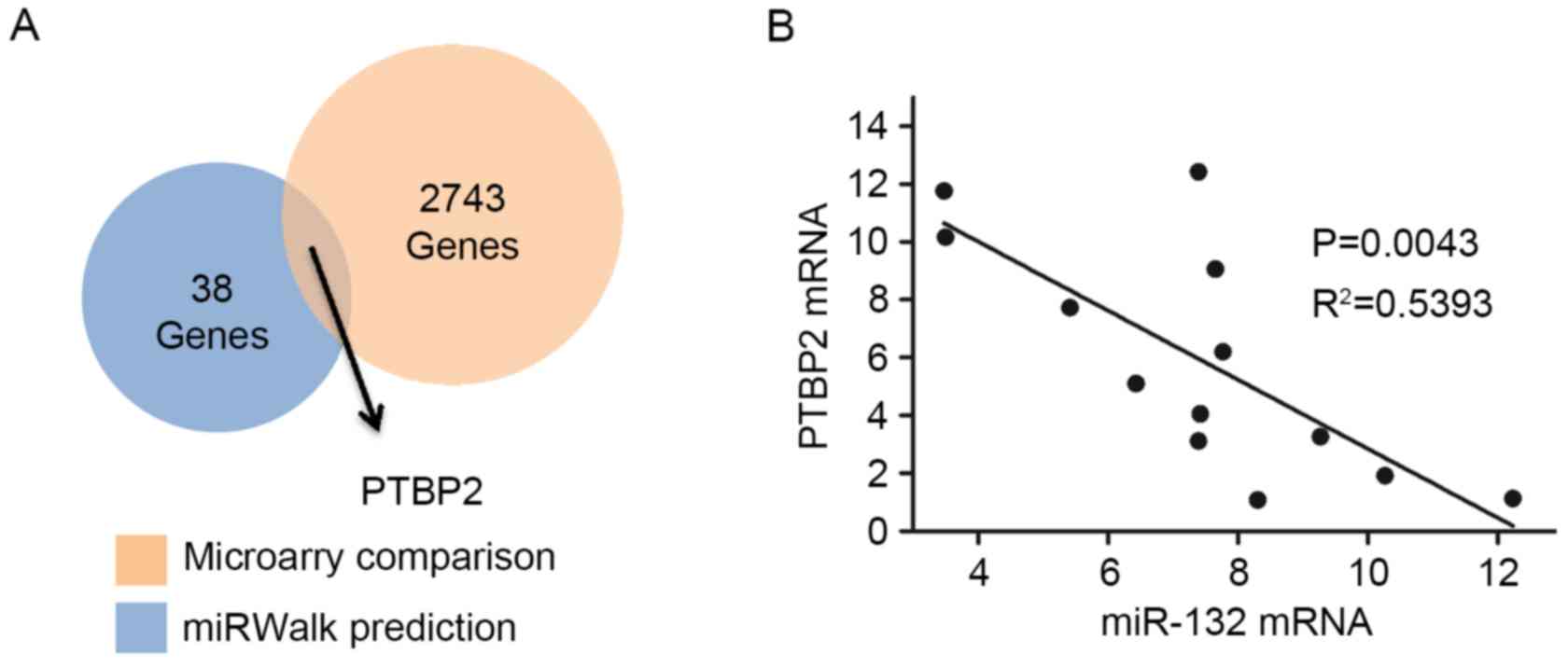Oncogenic miR‑132 sustains proliferation and self‑renewal potential by inhibition of polypyrimidine tract‑binding protein 2 in glioblastoma cells
- Authors:
- Published online on: September 21, 2017 https://doi.org/10.3892/mmr.2017.7572
- Pages: 7221-7228
-
Copyright: © Lou et al. This is an open access article distributed under the terms of Creative Commons Attribution License.
Abstract
Introduction
Glioblastoma multiforme (GBM) is one of the most aggressive and lethal type of malignant tumor of the central nervous system (CNS) (1–3), which is characterized by its fast growth and unlimited self-renewal potential. Despite development of therapeutic strategies for GBM, the overall survival of patients improved marginally, with a 5-year survival rate of just 9% (2). Therefore, more precise prognostic predictors and more effective therapeutic approaches are urgently required for patients.
MicroRNAs (miRNAs) are single-stranded non-coding RNAs with 19–23 oligonucliotides, which bind to the 3′-untranslated region of target genes, induce degradation and partake in virtually all biopathological steps. Increasing evidence indicates that miRNAs regulate the diverse biological steps of carcinogenesis and progression in cancer (4). Additionally, dysregulation of miRNA exhibits oncogeneic and tumor suppressor properties (4,5). Human microRNA-132 (has-miR-132), located in ch.17, is aberrantly expressed in gastric cancer, chronic lymphocytic leukemia, hepatocellular carcinoma and colorectal cancer (CRC) (6–9). Furthermore, as a central nervous system-specific miRNA, miR-132 displays vital roles in neurogenesis, neuron stem cell differentiation and development (10–13). Its dysregulation results in various types of brain-associated disease, including Huntington's disease, Parkinson's disease and schizophrenia (14,15). Previously, miR-132 was detected to be highly expressed in glioma, serving as a biomarker of a poor prognosis in patients (16). However, the functions of miR-132 in GBM stemness are complex and require further exploration.
In the present study, the potential bias from sample size was minimized by enrolling the GBM specimens from The Cancer Genome Atlas (TCGA) Research Network and investigated the clinical significance of miR-132. A high level of miR-132 was identified to be significantly correlated with neural subtype of GBM and a poor outcome for patients. Furthermore, a Gene-Cloud of Biotechnology Information (GCBI) bioinformatics analysis was performed to investigate the GEO datasets and the results revealed that miR-132 fuels proliferation and self-renewal potential potentially by targeting polypyrimidine tract-binding protein 2 (PTBP2) in GBM cells.
Materials and methods
Cell culture and sphere culture
The U87 GBM cell line was purchased from the Chinese Academy of Sciences Cell Bank (Shanghai, China) and cultured in Gibco Dulbecco's modified Eagle's medium (DMEM; Thermo Fisher Scientific, Inc., Waltham, MA, USA) with 10% fetal bovine serum (FBS). The conditional culture medium, Gibco DMEM/F12 (Thermo Fisher Scientific, Inc.) was supplemented with Invitrogen B27 (1X; Thermo Fisher Scientific, Inc.), 20 ng/ml basic fibroblast growth factor and 20 ng/ml epidermal growth factor (both from PeproTech, Inc., Rocky Hill, NJ, USA). First generation U87-neurospheres were observed in all wells of a 6-well plate 72 h later. All cultures were maintained at 37°C in an atmosphere of 5% CO2.
RNA isolation and reverse transcription-quantitative polymerase chain reaction (RT-qPCR)
The miRNA was extracted with RNAiso for small RNA (Takara Bio, Inc., Otsu, Japan) and miR-132 was examined using a TaqMan microRNA Assay (Thermo Fisher Scientific, Inc.) with U6 serving as the internal control. Total mRNA extraction was performed using TRIzol (Takara Bio, Inc.) from U87 cells and fresh glioma specimens. The fresh specimens were obtained from resected samples from glioma patients in the Chongqing Cancer Hospital (Chongqing, China). Expression levels of PTBP2 and GAPDH were measured using an RT-PCR kit (cat no. RR055A; Takara Bio, Inc.) according to the manufacturer's instructions and a CFX 96 system (Bio-Rad Laboratories, Inc., CA, USA). Each sample was examined in triplicate and analyzed according to the 2−ΔΔCq method (17) and GAPDH served as the internal control in the assay. The PCR reaction was run as follows: 95°C for 30 sec, 39 cycles of 95°C for 5 sec and 60°C for 30 sec. The primer sequences for qPCR were as follows: Forward, 5′-TGGATCCCCCCCAGTCCCCGTCCCTCAG-3′ and reverse, 5′-TGAATTCGGATACCTTGGCCGGGAGGAC-3′ for miR-132; forward, 5′-GCGCGTCGTGAAGCGTTC−3′ and reverse, 5′-GTGCAGGGTCCGAGGT-3′ for U6; forward, 5′-GCAACCGAGGAAGCAGCTATT-3′ and reverse, 5′-GCCTGAGCACGTTGGTTTAATG-3′ for PTBP2; forward, 5′-TGTGGGCATCAATGGATTTGG-3′ and reverse, 5′-ACACCATGTATTCCGGGTCAAT-3′ for GAPDH.
miRNA reagent transfection
The miR-132 mimic and control reagents were obtained from Guangzhou RiboBio Co., Ltd. (Guangzhou, China). U87 cells with 75% confluence were transfected with Invitrogen Lipofectamine 2000 (Thermo Fisher Scientific, Inc.). The culture medium with DMEM containing 10% FBS was replaced within 6 h. The miR-132 mimic was as follows: UAACAGUCUACAGCCAUGGUCGACCAUGGCUGUAGACUGUUAUU; and the miR-132 control: UUCUCCGAACGUGUCACGUTTACGUGACACGUUCGGAGAATT.
Cell proliferation assay
The proliferation ability of glioma cells was measured using a Cell Counting Kit-8 (CCK8; Beyotime Institute of Biotechnology, Haimen, China). U87 cells (5×104) with miRNA reagent transfection or untreated cells were seeded into 96-well plates and cultured for 0, 12, 24, 48 and 72 h. At each time interval, CCK8 (20 µl) was added to each well. Following 2 h incubation at 37°C, the absorbance was examined with a Multiskan (Thermo Fisher Scientific, Inc.) at a wavelength of 450 nm.
Sphere formation assay and colony formation assay
Both sphere formation assay and colony formation assay were performed to evaluate the self-renewal ability of U87 cells. According to our previous study (18), different numbers (20, 50 or 100) of cells were seeded into a 96-well plate. Serum-free medium (25 µl) was added to each well every 2 days. Plates were incubated for 2 weeks at 37°C in an atmosphere of 5% CO2 until neurospheres formed and the number of spheroid cells was counted for statistical analysis.
Colony formation ability was investigated by seeding U87 cells into a 6-well plate 6 h after transfection. Plates were incubated for 14–21 days until colonies were large enough to be visualized. Subsequently, colonies were fixed and stained in crystal violet (1%) for 10 min. The number of colonies was counted manually under an inverted microscope (Leica Microsystems GmbH, Wetzlar, Germany).
Bioinformatics analysis
TCGA (http://cancergenome.nih.gov) Research Network, a huge tumor profiling data set for a very large collection of tumor types, was mined in order to evaluate the predictive value of miR-132 in GBM specimens (n=526). A comprehensive bioinformatics analysis approach (GCBI; https://www.gcbi.com.cn/gclib/html/index), which was deeply integrated with the Affymetrix Gene Chip in GEO database, was used to enrich the dataset for genes, including the heat map analysis, volcano map analysis, gene ontology (GO) analysis and pathway analysis (19,20). In order to compare the different expression genes between groups of neurosphere cell lines with miR-132 transfection (GCS24468, GCS24458 and GCS24463) or control transfection (GCS24456, GCS24465 and GCS24464) (19), heat mapping was performed. To further analyze the functions of different expression genes on the basis of biological processes and molecular function, GO analysis was performed. In addition, pathway analysis was used to establish the significant pathway of differential genes according to the Kyoto Encyclopedia of Genes and Genomes (KEGG; www.genome.jp/kegg/), BioCarta's pathways (http://www.biocarta.com/genes/index.asp) and Reatome pathway databases (http://www.reactome.org). In order to establish the downstream targets of miR-132, five renowned miRNA prediction databases (TargetScan, www.targetscan.org/vert_71; miRanda, www.microrna.org/microrna/home.do; miRDB, www.mirdb.org; miRWalk, zmf.umm.uni-heidelberg.de/apps/zmf/mirwalk/index.html; RNA22, cm.jefferson.edu/rna22) were bioinformatically scanned as previously described (18,21).
Patient specimens
Newly diagnosed GBM patients who had received no previous treatment from 01/2015 to 01/2016 were enrolled in the present study. A total of 13 fresh GBM specimens were obtained from these patients straight after surgery at the Department of Neurosurgery, The Chongqing Cancer Hospital (Chongqing, China). Specimens were pre-mixed with liquid nitrogen at −80°C and ground. Following TRIzol (Takara Bio, Inc.) was added, the samples were prepared for the extraction of miRNA/mRNA following the related protocol. Written informed consent was obtained from each patient according to the national regulations of clinical samples and the study was approved by the Ethics Board of The Chongqing Cancer Hospital.
Statistical analysis
All statistical analyses were performed using SPSS software (version 20.0; IBM Corp., Armonk, NY, USA). The expression levels of miR-132 in different subtypes of GBM were compared using Student's t-test, and the χ2 test was used to analyze the correlation between miR-132 and the GBM subtypes. X-tile software (version 3.6.1; Yale University, New Haven, CT, USA) was used to determine the cutoff value of miR-181c according to previously reported instructions (18). Kaplan-Meier survival curve and the log-rank test were performed to compare the overall survival (OS) in patient groups. COX's proportional hazard regression model was established for multivariate analysis of the prognostic value of each factors. P<0.05 was considered to indicate a statistically significant difference.
Results
miR-132 is correlated with molecular subtypes and predicts patient outcomes
It has been reported that miR-132 was overexpressed in a cohort of 43 patients with glioma and correlated with unfavorable clinical outcomes (16). In order to minimize the system bias caused by sample scale, a GBM cohort (n=526) was included, which was obtained from TCGA database to analyze the expression level of miR-132. GBM is divided into four molecular subtypes according to gene expression patterns; classical, mesenchymal, neural and proneural (22). The results indicated that miR-132 was markedly higher in the neural subtype (8.625±0.077; n=84) than that in the three other subtypes [8.625±0.055 for classical subtype (n=138), 8.132±0.051 for mesenchymal subtype (n=154) and 8.183±0.056 for proneural subtype (n=125; P<0.01) as presented in Fig. 1A]. To examine the association between miR-132 expression and GBM patient outcome, a meaningful approach to classify the cutoff value (8.0) for the miR-132 expression level was set using X-tile software (P=0.0463; Fig. 1B). Results revealed that >80% of patients with the neural subtype of GBM demonstrated a higher expression level of miR-132, as compared with patients with the classical subtype (63.04%), the mesenchymal subtype (53.90%) and the proneural subtype (57.60%) (P<0.01; Fig. 1C). According to the cutoff value, patients were then split into two groups (miR-132High and miR-132Low). High miR-132 expression (>8.0) indicated a worse prognosis, with a median OS of 425.0 days (n=205) vs. 441.0 days (n=321) in the low-expression group (<8.0; P<0.05; Fig. 1D). In addition, the Cox hazard regression model was applied to evaluate the predictive value of miR-132 for GBM patients. Results demonstrated that miR-132 was an independent prognostic factor for predicting the patient outcome (P<0.05; hazard ratio, 1.204; 95% confidence interval, 1.040–1.395; Table I). Collectively, these results indicate that miR-132 was correlated with the GBM subtypes and serve as a robust prognostic indicator for GBM patients.
Table I.Univariate and multivariate analysis of the predictive value of miR-132 and clinical features for The Cancer Genome Atlas glioblastoma multiforme patients. |
miR-132 fuels proliferation, as well as self-renewal of U87 cells
miR-132 was reported to inhibit U87 cell invasion and metastasis (23), indicating its anticancer potential. Furthermore, the data demonstrated that miR-132 acted as an oncogenic miRNA during GBM progression. miR-132 expression levels were identified to be higher in U87 sphere, as compared with U87-monolayer cells (P<0.01; Fig. 2A). The miR-132 mimic was transfected into the U87 cells to elevate the expression level of endogenous miR-132 (Fig. 2A). Following pre-treatment of the U87 cells with miR-132 mimic, the proliferation ability was significantly enhanced at 48 and 72 h, as compared with U87 cells in the control group (P<0.01; Fig. 2B). To further investigate the effect of miR-132 on self-renewal in U87 cells, two representative assays (sphere formation and colony formation assays) were performed. The sphere formation assay indicated that miR-132 overexpression significantly enhanced the sphere formation potential of the cells when compared with the control group, which was treated with PBS (P<0.01; Fig. 2C and D). For the colony formation assay, no significant increase/decrease was observed within the groups of U87 with or without miR-132 treatment (P>0.05; Fig. 2E and F). These results demonstrated that a high expression level of miR-132 promotes proliferation, as well as self-renewal potential of U87 cells.
Microarray based bioinformatics analysis revealed the role of miR-132 in GBM cells
To further elucidate the mechanisms underlying the method by which miR-132 promotes GBM proliferation and maintains the sphere formation properties of U87 cells, a genetic bioinformatics database, the GCBI was searched, which provides a web-lab with bioinformatics approaches to manage numerous microarray results (19). The Affymetrix Gene Chip was obtained (control group vs. miR-132 transfected group) from the GEO database and run in the GCBI web-lab. Following the unsupervised hierarchical clustering analysis, differently expressed genes were selected according to their P-value threshold and represented in a heat map, as well as in a volcano map (Fig. 3A and B). The results revealed that 3,121 genes were overexpressed and 2,742 genes were downregulated following miR-132 overexpression in GBM cells (data not shown). To elucidate the miR-132-associated biological processes and underlying mechanisms, GO analysis was applied and the results demonstrated that significant GO pathways were screened according to their P-values. The representative top 15 significant GO pathways are presented in Fig. 3C. An additional method to identify the associated signaling pathways is evaluation by their enrichment score (24). The representative top 15 enriched signaling pathways are presented in Fig. 3D. To investigate the pathway interactions in miR-132 overexpressed GBM cells, the pathway interaction-based network was also applied. The results indicated that following miR-132 transfection in GBM cells, only gliomas, the ErbB signaling pathway, the adherens junction, proteasomes, CRC, pancreatic cancer, chronic myeloid leukemia, thyroid cancer and the extracellular matrix-receptor (ECM-receptor) interaction were definitely upregulated (as demonstrated by red spheres; Fig. 4). Furthermore, other signaling pathways/functional pathways are represented by yellow spheres, which indicates that these pathways may be upregulated by certain pathways but downregulated by some other signaling pathways (Fig. 4). Taken together, the results demonstrated that miR-132 transfection in GBM cells significantly altered a great number of genes and induced activation of various downstream signals, leading to sustained proliferation and sphere formation. However, the detailed mechanisms require further investigation.
PTBP2 was the downstream target of miR-132 in GBM cells
The GCBI successfully revealed 2,743 genes, which where downregulated in miR-132 transfected GBM cells. miRWalk was used to predict the miR-132 target genes (21). A total of 38 genes were commonly predicted in at least five of the six miRNA prediction databases (miRanda, miRDB, miRWalk, PICTAR5, RNA22 and Targetscan). Notably, PTBP2 was the only common gene of the 38 predicted genes and the 2,743 downregulated genes (Fig. 5A). To further elucidate the miR-132/PTBP2 regulation mechanism, 13 fresh GBM specimens were obtained from GBM patients and the expression levels of miR-132 and PTBP2 were examined. Subsequently, a linear regression model demonstrated that miR-132 and PTBP2 were negatively correlated in the GBM specimens (R2=0.5393, P<0.01; Fig. 5B). Thus, these results indicate that PTBP2 was a putative downstream target of miR-132 in GBM cells.
Discussion
Despite the availability of surgical treatment and chemoradiotherapy, patients with GBM continue to experience unfavorable outcomes (2,3). A notably malignant behavior of GBM is its unlimited proliferation potential, which leads to recurrence following surgery. Increasing evidence demonstrates that miR-132 is essential during tumorigenesis and progression. While, the role of miR-132 remains unclear, it may serves as either an oncogene or tumor suppressor depending on the tumor type (8,9,16,25).
In ovarian cancer cells, miR-132 suppresses cell proliferation, invasion and migration by targeting E2F transcription factor 5 (25). Downregulated miR-132 was detected in CRC specimens and associated with a poor prognosis in patients (8). In addition, miR-132 inhibits proliferation of hepatic carcinoma cells by targeting yes-associated protein (6). Furthermore, miR-132 expression levels were significantly increased in gastric cancer (GC) specimens and resulted in enhanced GC cell growth, which was mediated by the suppression of Forkhead box protein O1 (7). In human glioma tissues, high expression levels of miR-132 were widely detected and positively correlated with the WHO glioma grade (16), which indicated an oncogenic role in glioma cells. However, miR-132 was reported to inhibit the invasion and metastasis of U87, which is indicates a tumor suppressive function (23). Therefore, a comprehensive evaluation of miR-132 is required to evaluate its expression in GBM specimens. A total of 526 GBM specimens were obtained from the TCGA database to minimize the system bias resulting from sample size, and revealed miR-132 as a promising and potential independent prognostic indicator for GBM patients. The clinical functions of miR-132 in GBM cells were quickly verified in vitro with an interesting result, which indicated that miR-132 may serve as an oncogenic miRNA during GBM progression.
The identified molecular subtypes may underlie differences in patient sensitivity to therapy and prognosis (22,26). Notably, miR-132 was significantly elevated in the neural subtype of GBM specimens. According to previous reports, neural subtype is not sensitive to concurrent chemoradiotherapy or temozolomide (26). In addition, according to the classification approach used by Phillips et al (26), the neural subtype belongs to a proliferative subclass, which has a much shorter median survival time when compared with proneural and mesenchymal subclassess (26). The present study demonstrated that miR-132 promoted the proliferation and self-renewal potential of U87 cells, which is consistent with a previous study (26).
To further elucidate the underlying mechanisms of how miR-132 regulates proliferation and self-renewal of U87 cells, the GEO microarray database was searched and the miRWalk web tool was used to predict miR-132 target genes. PTBP2 was identifies as the only common gene within the downregulated gene pool in the GEO microarray and miRWalk prediction gene pool.
PTBP2 belongs to the polypyrimidine tract binding (PTB) proteins, is primarily detected in brain tissues and regulates tissue-specific post-transcriptional functions during neuron development and pathological processes (27). In osteosarcoma, the combination of PTBP2/PTB-associated splicing factor inhibited cell proliferation, migration, invasion and the epithelial-mesenchymal transition processes (28). However, its function in the CNS is quite specific and different. A previous study revealed that the PTBP2 level induced various splicing programs including the differentiation of neuron stem cell, early differentiating neuron splicing, and synaptic maturation (29). PTBP2 was demonstrated to promote proliferation and migration in the human glioma cell lines, U251 and LN229 (30). However, in another glioma cell, T98 G, the expression level of PTBP2 was lower than that of healthy brain tissues (31). In the present study, PTBP2 was downregulated in glioma stem cells and served as a tumor suppressor, which was revealed as a promising downstream target of miR-132 during GBM progression.
In conclusion, the results indicate that the miR-132/PTBP2 signaling pathway may sustain U87 cell proliferation and self-renewal, and elucidate the potential role exerted by miRNAs in GBM. In addition to highlighting the ability of miRNAs, the present study demonstrated the complexity of the underlying mechanisms regulating GBM progression. There are certain limitations in the present study. The fresh sample size was small and needs to be increased to be of statistical value. The only cell model used in the present study was U87, to verify the results and conclusions, more cells need to be used in the future. Detailed underlying mechanisms require further investigation, which will be the focus of future studies by the authors.
Acknowledgements
The authors would like to thank the central lab for providing technical instruction and assistance. The authors would also like to thank Dr Chen Dewei for his assistance with bioinformatics data mining. The present study was supported by the National Natural Science Foundation of China (grant no. 81502283).
References
|
Chen W, Zheng R, Baade PD, Zhang S, Zeng H, Bray F, Jemal A, Yu XQ and He J: Cancer statistics in China, 2015. CA Cancer J Clin. 66:115–132. 2016. View Article : Google Scholar : PubMed/NCBI | |
|
Miller KD, Siegel RL, Lin CC, Mariotto AB, Kramer JL, Rowland JH, Stein KD, Alteri R and Jemal A: Cancer treatment and survivorship statistics, 2016. CA Cancer J Clin. 66:271–289. 2016. View Article : Google Scholar : PubMed/NCBI | |
|
Siegel RL, Miller KD and Jemal A: Cancer statistics, 2016. CA Cancer J Clin. 66:7–30. 2016. View Article : Google Scholar : PubMed/NCBI | |
|
Berindan-Neagoe I, Pdel C Monroig, Pasculli B and Calin GA: MicroRNAome genome: A treasure for cancer diagnosis and therapy. CA Cancer J Clin. 64:311–336. 2014. View Article : Google Scholar : PubMed/NCBI | |
|
Chen CZ: MicroRNAs as oncogenes and tumor suppressors. N Engl J Med. 353:1768–1771. 2005. View Article : Google Scholar : PubMed/NCBI | |
|
Lei CJ, Li L, Gao X, Zhang J, Pan QY, Long HC, Chen CZ, Ren DF and Zheng G: hsa-miR-132 inhibits proliferation of hepatic carcinoma cells by targeting YAP. Cell Biochem Funct. 33:326–333. 2015. View Article : Google Scholar : PubMed/NCBI | |
|
Li W, Zhang J, Chen T, Yin P, Yang J and Cao Y: miR-132 upregulation promotes gastric cancer cell growth through suppression of FoxO1 translation. Tumour Biol. Aug 23–2015.(Epub ahead of print). | |
|
Mokutani Y, Uemura M, Munakata K, Okuzaki D, Haraguchi N, Takahashi H, Nishimura J, Hata T, Murata K, Takemasa I, et al: Down-Regulation of microRNA-132 is associated with poor prognosis of colorectal cancer. Ann Surg Oncol. 23 Suppl 5:S599–S608. 2016. View Article : Google Scholar | |
|
Tavolaro S, Colombo T, Chiaretti S, Peragine N, Fulci V, Ricciardi MR, Messina M, Bonina S, Brugnoletti F, Marinelli M, et al: Increased chronic lymphocytic leukemia proliferation upon IgM stimulation is sustained by the upregulation of miR-132 and miR-212. Genes Chromosomes Cancer. 54:222–234. 2015. View Article : Google Scholar : PubMed/NCBI | |
|
Makeyev EV, Zhang J, Carrasco MA and Maniatis T: The MicroRNA miR-124 promotes neuronal differentiation by triggering brain-specific alternative pre-mRNA splicing. Mol Cell. 27:435–448. 2007. View Article : Google Scholar : PubMed/NCBI | |
|
Magill ST, Cambronne XA, Luikart BW, Lioy DT, Leighton BH, Westbrook GL, Mandel G, Goodman RH, et al: microRNA-132 regulates dendritic growth and arborization of newborn neurons in the adult hippocampus. Proc Natl Acad Sci USA. 107:20382–20387. 2010; View Article : Google Scholar : PubMed/NCBI | |
|
Kawashima H, Numakawa T, Kumamaru E, Adachi N, Mizuno H, Ninomiya M, Kunugi H and Hashido K: Glucocorticoid attenuates brain-derived neurotrophic factor-dependent upregulation of glutamate receptors via the suppression of microRNA-132 expression. Neuroscience. 165:1301–1311. 2010. View Article : Google Scholar : PubMed/NCBI | |
|
Shaked I, Meerson A, Wolf Y, Avni R, Greenberg D, Gilboa-Geffen A and Soreq H: MicroRNA-132 potentiates cholinergic anti-inflammatory signaling by targeting acetylcholinesterase. Immunity. 31:965–973. 2009. View Article : Google Scholar : PubMed/NCBI | |
|
Miller BH, Zeier Z, Xi L, Lanz TA, Deng S, Strathmann J, Willoughby D, Kenny PJ, Elsworth JD, Lawrence MS, et al: MicroRNA-132 dysregulation in schizophrenia has implications for both neurodevelopment and adult brain function. Proc Natl Acad Sci USA. 109:3125–3130. 2012; View Article : Google Scholar : PubMed/NCBI | |
|
Lee ST, Chu K, Im WS, Yoon HJ, Im JY, Park JE, Park KH, Jung KH, Lee SK, Kim M and Roh JK: Altered microRNA regulation in Huntington's disease models. Exp Neurol. 227:172–179. 2011. View Article : Google Scholar : PubMed/NCBI | |
|
Liu Q, Liao F, Wu H, Cai T, Yang L, Wang ZF and Zou R: Upregulation of miR-132 expression in glioma and its clinical significance. Tumour Biol. 35:12299–12304. 2014. View Article : Google Scholar : PubMed/NCBI | |
|
Livak KJ and Schmittgen TD: Analysis of relative gene expression data using real-time quantitative PCR and the 2(-Delta Delta C(T)) method. Methods. 25:402–408. 2001. View Article : Google Scholar : PubMed/NCBI | |
|
Ruan J, Lou S, Dai Q, Mao D, Ji J and Sun X: Tumor suppressor miR-181c attenuates proliferation, invasion, and self-renewal abilities in glioblastoma. Neuroreport. 26:66–73. 2015. View Article : Google Scholar : PubMed/NCBI | |
|
Setty M, Helmy K, Khan AA, Silber J, Arvey A, Neezen F, Agius P, Huse JT, Holland EC and Leslie CS: Inferring transcriptional and microRNA-mediated regulatory programs in glioblastoma. Mol Syst Biol. 8:6052012. View Article : Google Scholar : PubMed/NCBI | |
|
An F, Zhan Q, Xia M, Jiang L, Lu G, Huang M, Guo J and Liu S: From moderately severe to severe hypertriglyceridemia induced acute pancreatitis: Circulating miRNAs play role as potential biomarkers. PLoS One. 9:e1110582014. View Article : Google Scholar : PubMed/NCBI | |
|
Dweep H, Sticht C, Pandey P and Gretz N: miRWalk - database: Prediction of possible miRNA binding sites by ‘walking’ the genes of three genomes. J Biomed Inform. 44:839–847. 2011. View Article : Google Scholar : PubMed/NCBI | |
|
Verhaak RG, Hoadley KA, Purdom E, Wang V, Qi Y, Wilkerson MD, Miller CR, Ding L, Golub T, Mesirov JP, et al: Integrated genomic analysis identifies clinically relevant subtypes of glioblastoma characterized by abnormalities in PDGFRA, IDH1, EGFR, and NF1. Cancer Cell. 17:98–110. 2010. View Article : Google Scholar : PubMed/NCBI | |
|
Wang H, Li XT, Wu C, Wu ZW, Li YY, Yang TQ, Chen GL, Xie XS, Huang YL, Du ZW and Zhou YX: miR-132 can inhibit glioma cells invasion and migration by target MMP16 in vitro. Onco Targets Ther. 8:3211–3218. 2015.PubMed/NCBI | |
|
Yang Z, Chen Y, Fu Y, Yang Y, Zhang Y, Chen Y and Li D: Meta-analysis of differentially expressed genes in osteosarcoma based on gene expression data. BMC Med Genet. 15:802014. View Article : Google Scholar : PubMed/NCBI | |
|
Tian H, Hou L, Xiong YM, Huang JX, Zhang WH, Pan YY and Song XR: miR-132 targeting E2F5 suppresses cell proliferation, invasion, migration in ovarian cancer cells. Am J Transl Res. 8:1492–1501. 2016.PubMed/NCBI | |
|
Phillips HS, Kharbanda S, Chen R, Forrest WF, Soriano RH, Wu TD, Misra A, Nigro JM, Colman H, Soroceanu L, et al: Molecular subclasses of high-grade glioma predict prognosis, delineate a pattern of disease progression, and resemble stages in neurogenesis. Cancer Cell. 9:157–173. 2006. View Article : Google Scholar : PubMed/NCBI | |
|
Zagore LL, Grabinski SE, Sweet TJ, Hannigan MM, Sramkoski RM, Li Q and Licatalosi DD: RNA binding protein Ptbp2 is essential for male germ cell development. Mol Cell Biol. 35:4030–4042. 2015. View Article : Google Scholar : PubMed/NCBI | |
|
Fang D, Yang H, Lin J, Teng Y, Jiang Y, Chen J and Li Y: 17β-estradiol regulates cell proliferation, colony formation, migration, invasion and promotes apoptosis by upregulating miR-9 and thus degrades MALAT-1 in osteosarcoma cell MG-63 in an estrogen receptor-independent manner. Biochem Biophys Res Commun. 457:500–506. 2015. View Article : Google Scholar : PubMed/NCBI | |
|
Zheng S, Gray EE, Chawla G, Porse BT, O'Dell TJ and Black DL: PSD-95 is post-transcriptionally repressed during early neural development by PTBP1 and PTBP2. Nat Neurosci. 15:381–388. 2012. View Article : Google Scholar : PubMed/NCBI | |
|
Cheung HC, Hai T, Zhu W, Baggerly KA, Tsavachidis S, Krahe R and Cote GJ: Splicing factors PTBP1 and PTBP2 promote proliferation and migration of glioma cell lines. Brain. 132:2277–2288. 2009. View Article : Google Scholar : PubMed/NCBI | |
|
Han W, Wang L, Yin B and Peng X: Characterization of a novel posttranslational modification in polypyrimidine tract-binding proteins by SUMO1. BMB Rep. 47:233–238. 2014. View Article : Google Scholar : PubMed/NCBI |



